Maybe you can relate to this: It’s 3:30. Your planning time, as usual, was consumed by a million other tasks. You need to prep literacy lessons to teach Short A CVC Words, but you just want to go home.
If you need quick and easy ideas, including a complete structured literacy lesson that is no-prep and free, then I’m glad you’re here!
In this post, I’ll share a resourceful list of short A CVC words you can use if you are in a last-minute pinch for word ideas. You can use these word lists for that critical decoding and encoding practice that young, especially at-risk, readers require. You’ll also learn some of the best methods I’ve used for teaching the short A CVC skill. Feel free to use these ideas with your own students tomorrow!
What Is the Short Sound of /a/?
Before we get to the list and the lesson ideas, let’s go over the articulatory aspects of this skill. Many teachers have sound walls in their classrooms for student reference, but how exactly do we make the sound of the short A?
The short a sound is often a middle vowel sound. When teaching your students how to replicate this sound, you can instruct them to open their mouth wide and slightly lower their jaw. While doing this, the tongue will be pushed forward ever so slightly so that the tongue’s tip is grazing the backside of the bottom teeth.
Keep in mind that there can be some slight sound variations when teaching certain word families with short A. For instance, words ending in -am and -an have more of a nasal tone than other short A word families. If you’re from the Midwest like I am, you might sound extra nasally. 🙂
What Is a Short A CVC Word?
This may seem like an overly basic question, but it’s worth mentioning, especially since short A will likely be the first vowel you will teach your children. What is a short A CVC word, or for that matter, what is a CVC word in general? If you’re a teacher, you know the answer. But if you are a parent, maybe it isn’t so obvious. I’ve been repeatedly shocked at how many “CVC” products on Amazon have words like “key”, “cow”, and “bee”. I just, regrettably, ordered CVC card sets with dozens of these non-examples of CVC words. So it got me wondering how confused non-teacher parents might be.
It’s important for our kids to understand the meaning of “CVC” and to know what “short A” means.
CVC stands for “consonant-vowel-consonant”. Being explicit is beneficial in introducing this phonics concept to students. When first teaching the pattern to my students, I would often label CVC words with the labels “C-V-C” just above them (or below) as a visual. This is also when I teach the concept of the closed syllable. When a syllable has one vowel followed by one or more consonants, the vowel makes its short sound, as opposed to its long sound (when the vowel “says its name”). We also say that in a closed syllable, the consonant “closes the door in the vowel’s face”, thus preventing it from saying its name. Stories like this help students remember this concept.
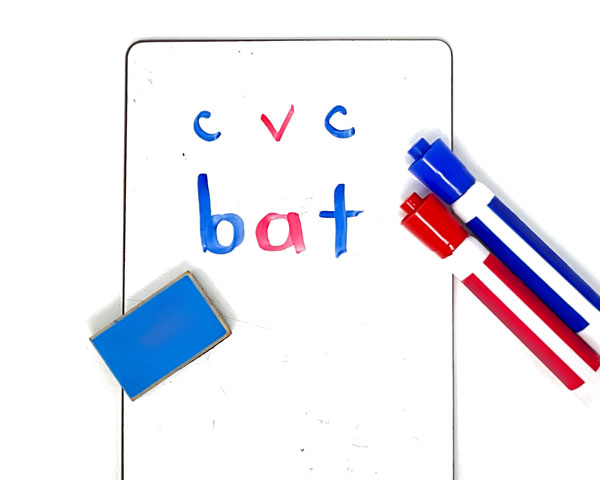
It’s helpful to show several examples like this to your students. You can even write some CVC words on the board and then have students come up and label the words while the rest of the group recites “C-V-C” or “consonant-vowel-consonant” so they can make the connection.
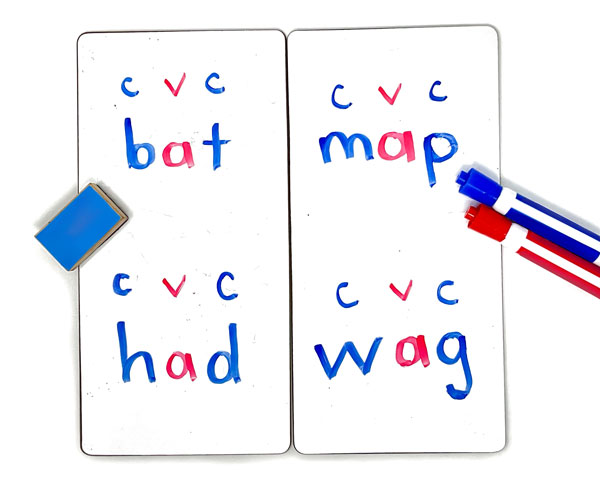
Please keep in mind that it’s important to teach our students that whenever they see this pattern, the “V” stands for “short vowel” or in the case of this example, “short A”.
What Are Words with Short A?
Now, let’s get to the words! Feel free to use the following short A CVC list of 63 words as inspiration for any lessons you have coming up.
I’ve purposefully excluded any words with blends or digraphs. This list is meant to be used when you are introducing short A CVC words for the first time. As such, most scope and sequences introduce this skill before introducing digraphs or blends.
Additionally, this word list does not include nonsense words (such as rab, gad, dat, etc.). However, you can certainly choose to include nonsense words in your instruction soon after introducing the concept. Many educators disagree on IF we should TEACH nonsense words, or just use them for assessment purposes. I find nonsense words to be beneficial in word chains and word sorts, but I don’t feel strongly enough to get into the debate on either side.
| Short A CVC Word Family | Short A CVC Words Within Each Word Family |
|---|---|
| -ab | cab, dab, gab, jab, lab, nab, tab |
| -ad | bad, dad, fad, had, lad, mad, pad, sad, tad |
| -ag | bag, gag, lag, nag, rag, sag, tag, wag |
| -am | dam, ham, jam, Pam, ram, Sam, yam |
| -an | ban, can, Dan, fan, man, pan, ran, tan, van |
| -ap | cap, gap, lap, map, nap, rap, sap, tap, yap, zap |
| -at | bat, cat, fat, hat, mat, pat, rat, sat, vat |
| -ax | fax, sax, tax, wax |
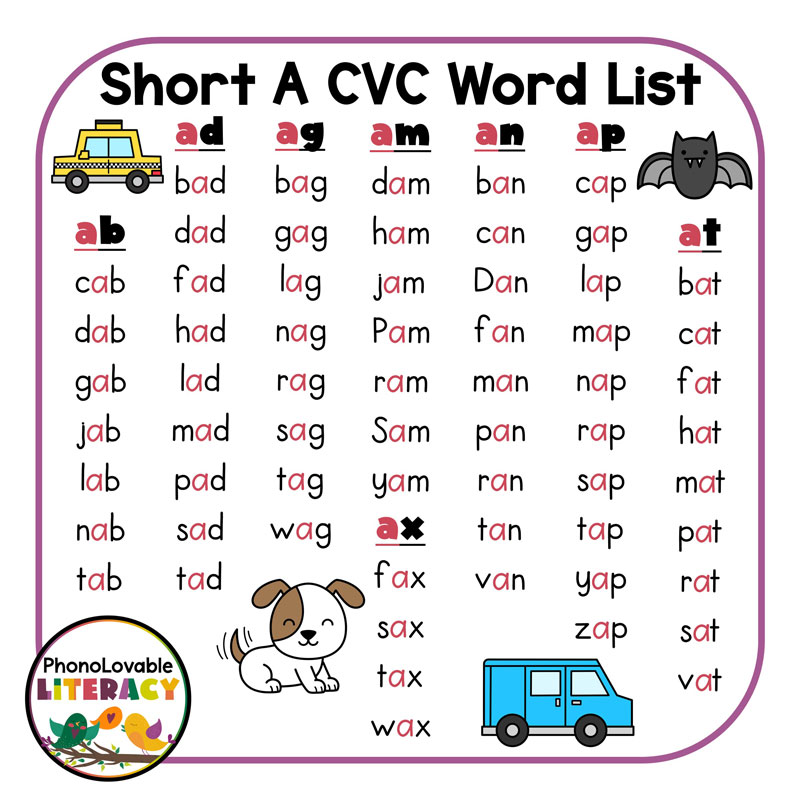
Feel free to pick and choose the words that suit the needs of you and your students the most! If your children have dry-erase boards and markers, you can lead an instant encoding word-chain lesson just by pulling up these word lists.
How Do You Teach the Short A Vowel in CVC Words?
You likely already have a program to teach Short A CVC words, but odds are there aren’t enough practice opportunities provided, especially for your at-risk readers. If that’s the case, I hope you and your students find the following ideas useful!
The lesson suggestions I discuss below come from a free set of NO-PREP digital slides I created called CVC Word Practice for Short A Digital Slides. It’s not mandatory to use these slides to teach short A CVC words. If you’d rather not get the free slides, you can use the ideas below as inspiration to use with your own materials and teaching style.
Introduce the Short A Sound with Guided Discovery (Speech-to-Print Approach)
Before you teach your students to read short A CVC words, here’s something to think about. Are children HEARING the sound first or SEEING the letter first? For years, I didn’t think the difference mattered. But the more I learned, the more I understood that starting with the speech sound BEFORE showing kids any printed letters was beneficial.
How do we do this? We can use a guided discovery approach. I learned about this in a Structured Literacy training I completed through my state’s department of education years ago.
To start, we can help our students make the connection in a meaningful way between the sound of short A and familiar things that begin with that same sound.
For example, you might present your students with a selection of photographs. These might include animals, objects, people, or places that begin with the short A sound. See this cute plushie friend below:

Say the word “alligator”, really dragging out the initial vowel sound, and then have your students repeat the word. Do this with four to five photographs of familiar things that begin with the short A sound.
Instruct your kids to pay attention to how their mouths feel as they form the first sound of each word. You might also have them look into a small mirror to see their mouth.
After students repeatedly make this sound for the beginning of each word, they soon “discover” that each word starts with the same sound! At this point, you can introduce the grapheme, or the letter representing the phoneme /a/.
Maximize Effectiveness with the Research-Based Method of Embedded Mnemonics
To drive the discovery home even further, present the letter “a” within an embedded mnemonic of an apple. Decades ago, research demonstrated that children learned letter-sound correspondences more quickly this way, AND they had better retention than the popular method of having a picture outside of the letter.
Ask students to say and hold onto the short /a/ vowel sound for as long as they can. It helps to sing it. Add a gesture if you’d like, such as pretending to bring an apple to your mouth to take a big bite.
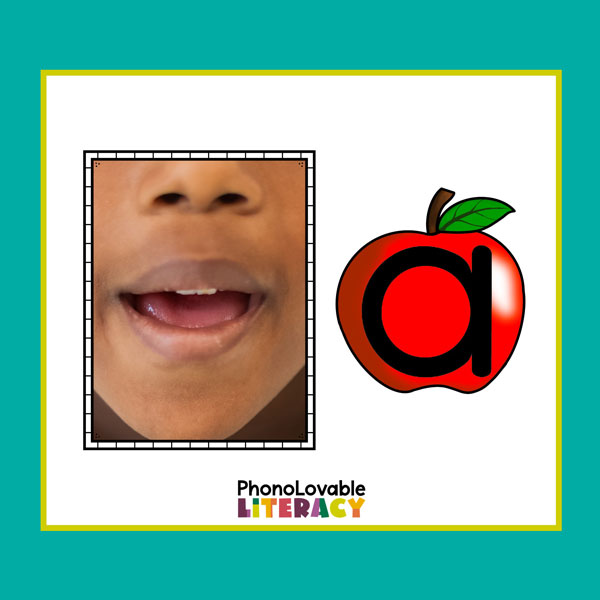
You may use the following short video for extra reinforcement:
By the way, if you’d like a free set of your own embedded mnemonic letter cards, you can get them here when you join our newsletter!
Optional Rhyming and Phonemic Awareness Warm-Up Activities
If you have students that could benefit from playing around with the sounds within short A CVC words before working with the letters, consider some of these practice activities:
Rhyme Time: Do These Words Rhyme?
Show your children different pairs of short A CVC words in picture form, such as “bat” and “mat”. Say each word and have students repeat the words after you. Ask students if the words rhyme. Have students respond by giving you a thumbs up or a thumbs down. As you can see from our Short A Digital Slides, you’ll be able to have your students confirm their guesses as you click through the slides and the correct answer is circled. If you want a digital-free option, just ask students to repeat each word after you say it.
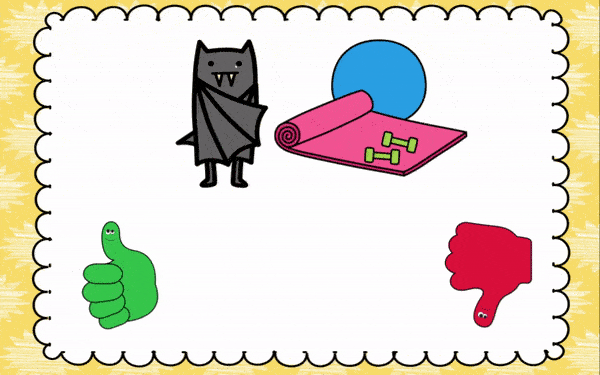
Rhyme Time: Which Word Belongs?
As an alternate rhyming activity, present students with three images of short A CVC words that rhyme. Then below these, provide them with two additional short A CVC words, one that does rhyme with the first three and one that does not. After some practice, your students should be able to tell which picture from below goes with the original three.
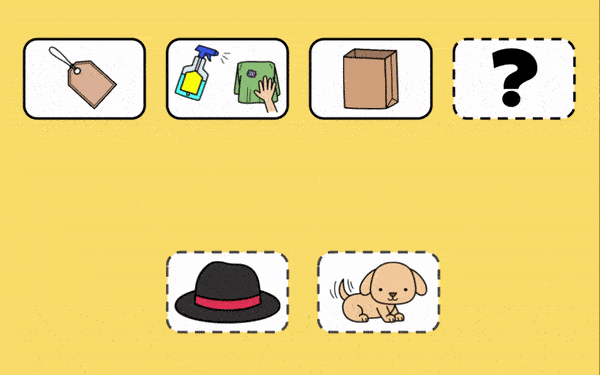
Initial Sound Substitution
In this section of our Short A Digital Slides, there are 8 opportunities to practice initial sound substitution with CVC words. In the example below, there’s a picture of a cab. Here, you would tell your students to first say the word “cab”. Then, have them change the /k/ sound in the word “cab” to /l/. Ask them “What’s the new word?” They should be able to say “lab”. Show the picture on the next slide to show students they are correct!
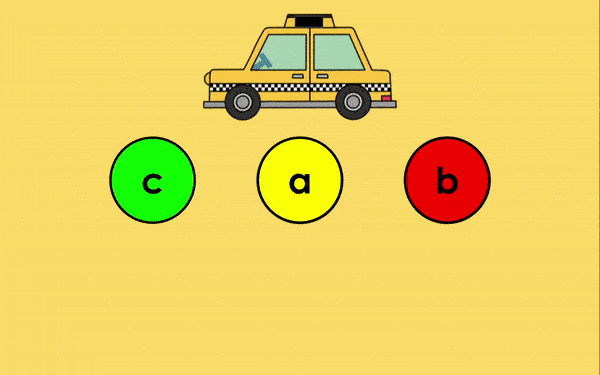
As a side note, you’ll notice that letters accompany the visuals in this task. Since there is research to support the integration of phonics with phonemic awareness, I left these editable letters in as an option. You can leave them or delete them based on the best needs for your students.
Short A CVC Decoding Practice
Now comes the time to teach your kids how to actually read some short A CVC words! I like to use the following types of slides to teach students how to decode. These slides encourage students to blend the sounds of each letter they see.
Rather than saying each sound in a choppy way, it’s a good idea to use the first few slides to model how to stretch one sound into another with continuous blending.
Each short A CVC word slide is followed by a picture slide. This allows students to check and see if the word was read properly.

The first ten slides of the blending/decoding section have the embedded mnemonic for the vowel as an additional support.
Real vs. Nonsense Word Sorting of Short A CVC Words
We all understand the importance of reading words accurately. Some kids love to look at the first letter of a word and guess, don’t they? These slides are a fun way for your students to practice word reading accuracy.
Students will see a word under the flying saucer. Tell students it’s their job to read the word and determine if it belongs on our planet (and needs to be given to the human boy) or if we should send it with our alien friend for him to take back to his planet.
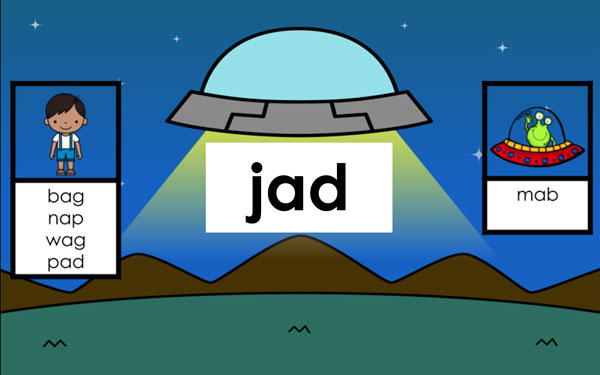
For the real words, you can challenge your students to come up with a sentence that makes sense.
Short A CVC “I Spy” Phoneme Segmentation Game
Have your students practice phoneme segmentation of short A CVC words with a fun game of I Spy.
To play this game, tell your kids that they will take turns acting like detectives and giving each other clues based on what they see. When students spy a short A word, like “rat”, they will have to say, “I spy a /r/ … /a/ … /t/.”
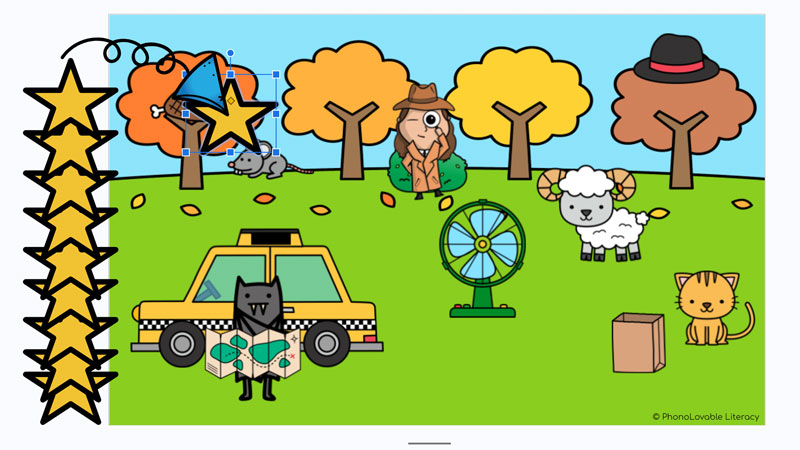
As another option, YOU may give all the clues, and it’ll be the students’ job to blend the sounds and tell you what word they could put together from them.
Encoding Practice of Short A CVC Words
It’s important that students get enough practice with both decoding and encoding. To transition from the phonemic awareness game to the encoding practice, tell students that they’ll use the same segmenting process from the I Spy game to help them write words. Ask students to get a paper and pencil or a dry erase board and marker for spelling practice.
Here’s a video demonstrating how you can use our digital slides to get your kids spelling short A CVC words. Feel free to play this video for your students while they participate!
You’ll start by saying the word of the picture, like this bat.
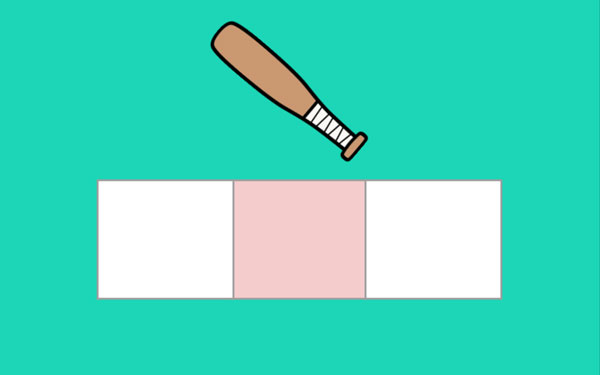
Ask students to segment the word into individual sounds as you click for the pointers to appear.
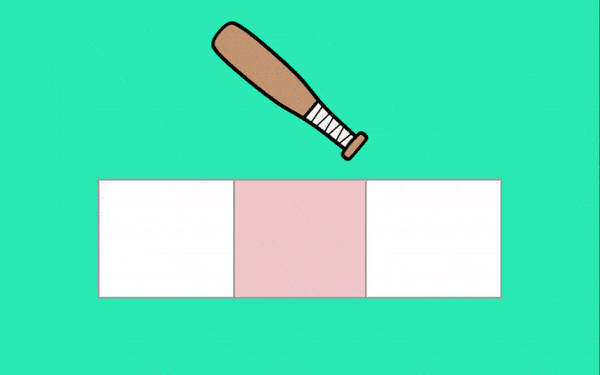
Have students say the sounds and then write the word on a piece of paper or dry erase board. Then, ask them to show you or tell you how to spell the word. Click for the correct letters to appear so they may check their writing.
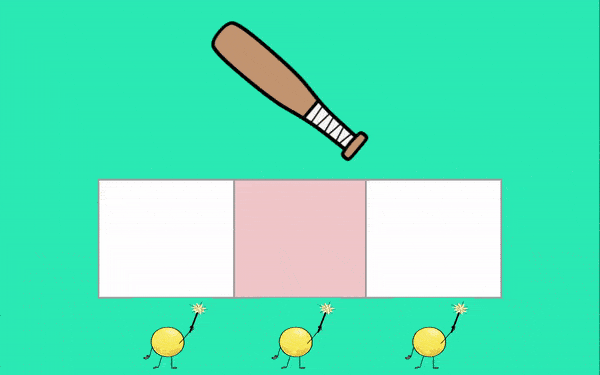
There are 15 of these words available in the digital slides for encoding practice.
Practice Word Chains with Mystery Pictures
To help your students practice their word reading fluency, you can share these mystery picture activities from the slides. These mystery pictures are a student favorite!
Simply display a slide of short a CVC words with a mystery picture hidden behind it. For a little bit of extra fun, you can have your students guess what the mystery picture is going to be. Hint … it’ll be a picture of a word containing a short A sound!
Starting at the top left, have your students read the word list in order from left to right. As each correct word is read, the box will disappear with the click of your mouse. Keep going until the words are all gone and the picture is revealed!
Read Decodable Sentences with Short A CVC Words
When your students feel more at ease with reading short A CVC words, it’s time to present decodable sentences that include the same kind of words.
You may want to introduce or reinforce any irregular, high-frequency words (or heart words) that will be in the decodable sentences.
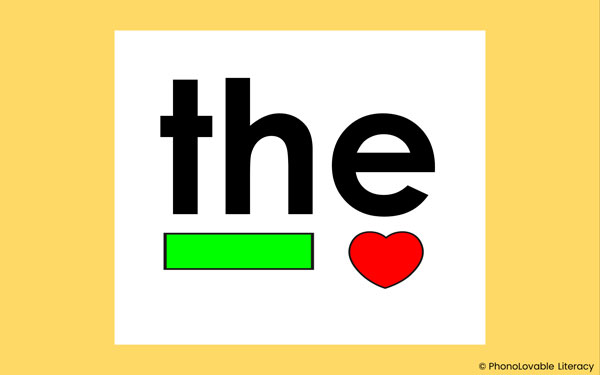
With our digital slides, you set the appropriate pace for your students to read each sentence as you click for each word to appear. Additionally, you can ask your kids to make a picture in their minds about what the sentence means to them. With one additional click, the next slide will show them a picture for the sentence.

Just because these sentences are decodable, that doesn’t mean your students have to read like robots! Take some opportunities to model and demonstrate for them how to “scoop” words into phrases to sound more natural.

Dictation Sentences That Include Short A CVC Words
Just as we want our students to read decodable sentences with short A CVC words, it’s equally important that they be able to write sentences like this. Wiley Blevins, in his book A Fresh Look at Phonics, recommends doing sentence dictation at least twice per week, beginning as early as Kindergarten.
Affiliate Disclaimer: The link above is an affiliate link. I will receive a small commission if a purchase is made through this link. Learn more here.
Ask students to get a paper and pencil or a dry erase board and marker for sentence writing practice. State a short sentence with a few short A CVC words, like the sentence “The cat has a hat.” Visually present a blank box for each word in the sentence. You can draw these boxes on the board, or if you are using our slides, simply click and a blank box will appear for each word.

After the students have written the words from the sentence on their paper or dry erase board, they can check their work as you click to reveal the proper spelling.
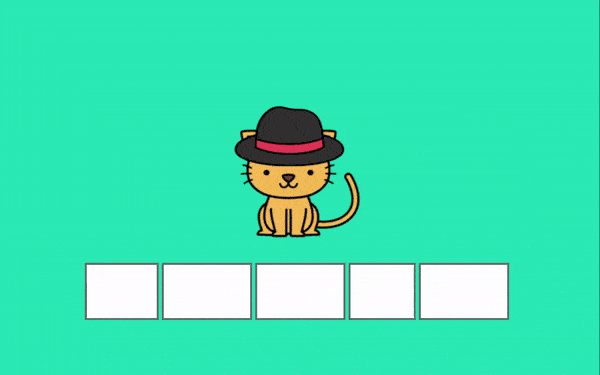
The free slides provide 8 sentence dictation opportunities for students to practice. You can pick and choose the ones you like. You can stretch them out over the week. If you would like a greater selection of short A CVC sentence dictation sentences, you can get ten more here in both printable PDF and digital format.
You’re All Set for a Structured Literacy Short A CVC Lesson
That’s it! I hope you’ve come away from this article with a few fresh ideas to use in your short A CVC lesson.
Please remember that although the suggestions and examples from this article feature the free Short A CVC digital slides I created, you can certainly improvise and do these same activities with your own classroom materials.
If you’d rather use the free digital slide resource, you can get it by clicking on the image below or at this link.
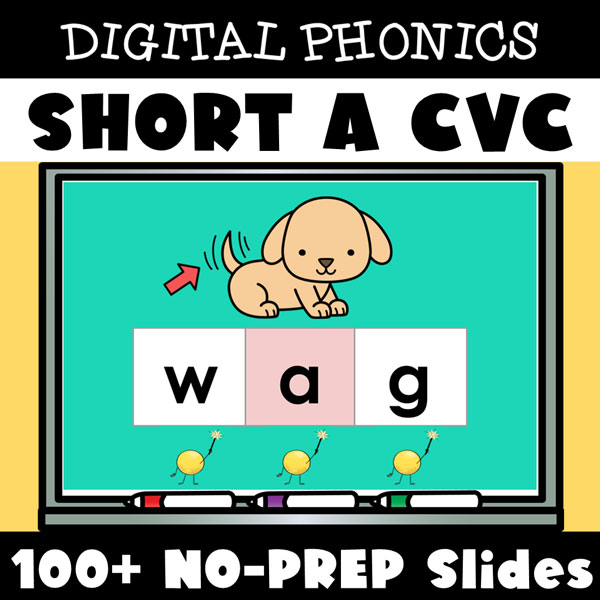
If you find these ideas useful but you teach students in 2nd or 3rd grade intervention or special education, you may want to consider getting this companion resource with real photographs. These appeal to older students who haven’t yet mastered short A CVC words, whereas the slides shown in this article are geared towards students in grades Kindergarten through early 2nd grade.
You may also be interested in my free short A worksheets or my Short Vowel Sounds CVC Word Practice Bundle that includes not only short A but all the other short vowel sounds, too. You’ll be able to watch the slides in action and preview each individual resource by clicking on the bundle link.
I wish all of your students an enjoyable and successful year of learning how to read!

